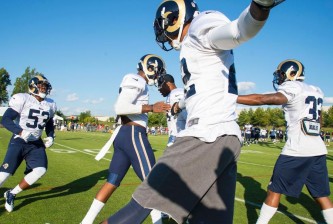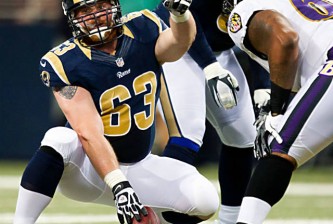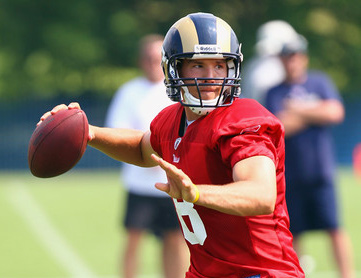Okay, first off, a disclaimer. ESPN obviously doesn’t entirely hate the Rams or Sam Bradford, or the ratings this rising team will pull in for their two Monday Night Football appearances this year. But they’re more than willing to stoke the fires of fan sentiment any way they can, while wearing the mantle of the “Sports Information Leader.”
Their latest ploy? The introduction of the “Total Quarterback Rating (QBR),” which they intend to use to put the old antiquated QB Rating system to bed. Their initial story, explaining the ranking, has the helpful headline: “How to Identify the NFL’s Best Quarterbacks.”
And at this point, Rams fans are thinking “YESSSSSS! Now that we finally have a quarterback worth bragging about, we’re about to get some love!”
Uh, no. In fact, you’ll find Bradford buried in the “below average” tier, lumped in uncomfortably next to Alex Smith, Jason Campbell and Chad Henne, and just a small step away from the untouchables like Derek Anderson and Jimmy Clausen. And when challenged, ESPN’s Stats and Info department is more than happy to clarify why the NFL’s offensive rookie of the year is tiered closer to it’s biggest busts than its elite talents.
 TheFakDaddy
TheFakDaddy@ESPNStatsInfo Sam Bradford is BELOW AVERAGE??? Therefore the system is flawed.
 ESPNStatsInfo
ESPNStatsInfoIssue w/ Bradford is air yards. Short passes w/ YAC=easy for QB
“Air yards?” Really? Let’s take a deeper look.
The immediate limitations of QBR, and the sabermetric trend in football
The problem here is that this is yet another statistic that is wholly divorced from context. The hard numerical quantification of this system (like the old QB rating) tells you certain things, and those things can be valuable for certain types of comparisons, but they fail to tell you the whole picture. The team’s improvement from one win to seven is wholly removed from the discussion. (Statistical analysts in all sports are notorious for their disdain of “wins” as a comparative stat.) Nowhere is there (or could there be) any quantification of the poise Bradford showed as a rookie, or the speed with which he grasped Pat Shurmur’s playbook, or the relative weakness of said playbook.
Doug Farrar of Football Outsiders and Yahoo! Shutdown Corner offers a brief rebuttal (to the rating system, not specifically on Bradford), but raises only one quibble with QBR: adjusting for strength of opponent.
I’m very intrigued to see where ESPN is going with Total QBR, but I won’t be totally on board until it’s used with more of a 3-D view, and players are held accountable for beating up on easy defenses, and rewarded for solving more challenging ones.
I hate to break it to you, but if we adjust for opponents, Bradford’s name probably slides even further down this rating, thanks to one of the easiest schedules the Rams have faced in ten years.
ESPN’s new rating is built very much on the shoulders of Aaron Schatz’s work at Football Outsiders, with a nod to the win probability stats developed by Brian Burke at Advanced NFL Stats, though apparently neither was consulted nor paid as part of the development process. Both of these guys are extremely intelligent analysts who got tired of living in a Phil Simms universe of football discussion. They were envious of the growing trend of sabermetric analysis popularized by Bill James in baseball, and wanted to apply that to the gridiron.
What ESPN’s QBR in particular does is try to quantify the importance and the value of the outcome of every single play a quarterback is involved in (except handoffs). It’s an ambitious work in progress.
But like Football Outsiders’ DYAR (Defense-adjusted Yards Above Replacement), rather than offer a telltale ranking of quarterbacks, what it does more effectively is offer a telltale ranking of passing systems, and mix in a heady dose of “clutchiness” to appease the Terry Bradshaws out there who love to talk about “knowing how to win.”
Peyton Manning and Tom Brady are great quarterbacks in advanced passing systems, and are deservedly ranked at the top. Matt Cassel is a mediocre quarterback with only one receiver in Charlie Weis’ thoroughbred passing system… and the effect balances out as “Average.” Tampa Bay’s Josh Freeman could go whole quarters without completing a pass, but made some amazing plays in the fourth quarter, and gets jetted up to “well above average.”
So while Bradford was remarkably efficient and consistent when he had the ball in his hands, he gets doubly penalized by the Rams’ brutally conservative game plan last year. Not only was he yoked into a 5-10 yard field by the playbook, he also had the ball taken out of his hands while the team tried to preserve even the slimmest of fourth-quarter leads. Few high-value passes, no time in the clutch. A lethal combination in the eyes of this rating.
Rebutting QBR re: Bradford, with a healthy dose of scouting tape
Count Football Outsiders’ Farrar among those willing to step outside the statistical box and dig deeper.
Bradford’s DYAR rating, to put it mildly, stunk in 2010. And Farrar was deeply puzzled by the apparent mismatch going on, having spent significant time scouting Sam Bradford and knowing what he was capable of. To add weight to the analysis, Farrar invited veteran NFL film grinder Greg Cosell to the discussion as the two analyzed Bradford’s season in progress. This amazing article still stands as the most substantive piece of analysis yet written on the Rams’ emergent season, and Bradford’s stunted-but-substantial role in it.
A typical observation from the stat corner:
“Of the 55 passes Bradford threw in that game, just a handful traveled more than 10 yards in the air before they were caught; he didn’t air it out until there were just 27 seconds left in the first half.”
The scouting report from the film jockey:
“I think it’s a multi-dimensional offense that has everything in it, and I know that for a fact, but they’re playing to their talent…. In the last couple of weeks, they’ve clearly designed plays in which the ball should go down the field. Sometimes it does. Sometimes, for reasons that have nothing to do with Bradford, it may not.”
Head-scratching and scorn for the gameplan, notably in the Detroit game after Mark Clayton went down:
“It seemed that offensive coordinator Pat Shurmur was retrofitting Bradford with the West Coast Offense Backup Quarterback System. But Bradford has distinct and different skills that put him above the fray.”
Despite the rough surroundings, the scouting eye detects qualities that statistics alone do not.
“Because of his accuracy, he will always make his receivers better in the long run,” Cosell said. “Because he’s very compact, and he’s very accurate. Believe me, I’m not comparing him to Tom Brady at this point in time, but I think he has attributes like that.”
And, the pull-quote that defines the problem in a nutshell:
“For the most part, Bradford managed the game he was given successfully, but the more I have watched this Rams offense this season, the more I’m wondering if Shurmur isn’t taking a Lamborghini and racing it around a supermarket parking lot.”
For all the hope that we’ve heaped on his shoulders, for all the qualities that we see in him even through his struggles, we know that Bradford is still very far from his ceiling as a pro. You simply can’t take this low rating by ESPN’s new statistical measure as a referendum on the future of the Rams’ franchise man.
I think Doug Farrar’s closing comment mirrors the thoughts and expectations of Rams Nation more perfectly than any statistical measure of his rookie season: “I’m waiting for the Sam Bradford I haven’t yet seen.”
We all are.























